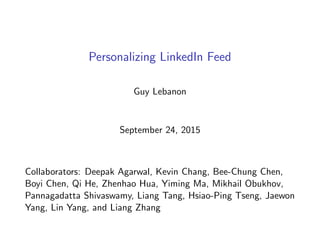
GT_feed
- 1. Personalizing LinkedIn Feed Guy Lebanon September 24, 2015 Collaborators: Deepak Agarwal, Kevin Chang, Bee-Chung Chen, Boyi Chen, Qi He, Zhenhao Hua, Yiming Ma, Mikhail Obukhov, Pannagadatta Shivaswamy, Liang Tang, Hsiao-Ping Tseng, Jaewon Yang, Lin Yang, and Liang Zhang
- 2. LinkedIn Feed: Value and Impact Main gateway to LinkedIn’s website and mobile app. Help users stay informed by showing news and other posts related to their career Help users stay connected to their professional network by showing updates from connections Help users establish their brand/reputation via sharing and posting. In addition, help user find jobs (JYMBII), grow network (PYMK), and generate ad revenue. Small tweaks make huge impact on hundreds of millions of LinkedIn members.
- 4. LinkedIn Feed: A Machine Learning Problem Recommendation system with a few twists: Heterogenous inventory: updates from my connections, jobs recommendations, news recommendations, ads, people you may know, etc. Explicit and Implicit signals: clicks, like, share, comment, VPT Different value for different member segment: job seeker, novice, consumer High quality profile Social graph data Spam and unprofessional content Online scoring of a very large number of candidate updates
- 5. Feed Relevance System multiple homogenous sources =⇒ each rank top-k =⇒ combine top-k lists into a single ranked list =⇒ reranking stage
- 6. Feed Mixer System Feed mixer combines top-k ranked lists Online component responds to web server request Offline component prepares training data, trains model, process features
- 7. Activities Most feed activities are formulated as (actor, verb, object) triplet, whose type (actor type, verb type, object type) is the activity type.
- 8. Model Ranking is based on logistic regression model capturing interactions (clicks, likes, etc.). If yit is a binary variable capturing whether user i interacted with update t, then P(yit = 1 | user, update) = 1 + exp j βj [Xit]j −1 where Xit is a vector describing the user i and update t and β is the model parameter vector. MLE training based on “random bucket” data that has a reduced serving bias. Big data and high dimensionality lead to distributed training procedures e.g., ADMM, Spark.
- 9. Features Xit = (Xi , Xt, Xik, Xij , Xijk, Xio) Xi : viewer features e.g., profile information Xt: update features e.g., actor type, verb type, etc. Xik viewer-activity type features “viewer-activity type affinity” (computed offline) Xij viewer actor features “viewer-actor affinity” (computed offline) Xijk viewer-actor-activity type features “contextual viewer-actor affinity” (partially computed offline) Xio viewer object features e.g., viewer-object content features
- 10. Affinity Features Double or triple interaction features such as Xij or Xijk are hard to scale due to the explosion of feature dimensionality. Solution: Build a separate model for viewer-actor affinity αij , viewer-activity type affinity αit, and contextual viewer-actor affinity αijk. Affinity models are trained via a separate pipeline and stored offline At serve time, relevant affinity scores are loaded from data store and are used as features in the CTR prediction model Decouples a very complex problem into several simpler problems and at the same time separates heavy computation in offline and fast loading in online.
- 11. Joint Feed Effects Some joint feed effects are hard to model using a “pointwise” model such as a CTR model. For example, we observe that engagement drops for non-diverse feeds
- 12. Joint Feed Effects We also observe that engagement drops for previously seen updates.
- 13. Reranking Ranking based on CTR scoring model cannot take into account entire feed. Reranker manipulates the CTR ranked list to have a better ranking and lower negative “joint feed effects”. Reranking stages include ensuring actor diversity (within session) ensuring actor diversity (cross session) ensuring update type diversity impression discounting additional “secret sauce”
- 14. Open Problems AB tests for social networks Explore/Exploit with minimal negative effect on member’s experience Likes, comments, shares create viral updates that propagate in a network. How do we measure impact of a social gesture on the eco-system Tradeoff between optimizing for consumers and producers Tradeoff between value to members and value to eco-system
- 15. Thank You Additional details can be found in the Feed Relevance KDD 2014 (Activity Ranking in LinkedIn Feed) and KDD 2015 (Personalizing LinkedIn Feed) papers on feed relevance.
